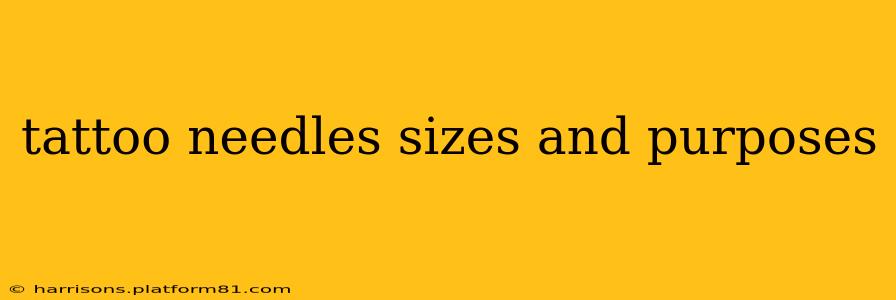Choosing the right tattoo needle is crucial for achieving the desired effect and ensuring a safe and comfortable experience. Tattoo needles come in a wide variety of sizes and configurations, each suited to a specific purpose. This guide will break down the different needle sizes and their applications, helping you understand how to select the appropriate needle for various tattoo styles and techniques.
What are the Different Tattoo Needle Sizes?
Tattoo needles are categorized by their grouping (number of needles) and diameter (gauge). The grouping refers to how many needles are bundled together in a single configuration. The gauge refers to the thickness of the individual needles; a lower gauge number indicates a thicker needle.
Grouping: This ranges from single needles (liners) to groups of up to 40 needles (magnums) or even more for shader bars. Common groupings include:
- 1 Liner: Used for fine lines and details.
- 3 Liner: Offers a bolder line than a 1 liner.
- 5 Liner: Creates thicker, more defined lines.
- 7 Liner: Suitable for larger outlines.
- Round Liners (RL): These are the most commonly used liners. The number indicates the number of needles bundled together.
- Magnum: Used for shading and filling in larger areas. Magnum needles are categorized by the number of needles arranged in a round or slightly curved configuration. A 5 magnum, for example, has 5 needles in a round formation. Larger magnums such as 9, 11, and 14 are used for larger fills.
- Round Shader (RS): These are similar to magnums, but the needles are more tightly grouped for smoother shading.
- Flat Shader (FS): These have needles arranged in a flat configuration, offering a more even and consistent shade.
- Magnums and shaders: These both are used for shading, but magnums pack more color, while shaders create softer transitions.
Gauge: This is usually expressed as a number; a lower gauge number indicates a thicker needle. Common gauge ranges are from 8 to 14, although some specialized needles might fall outside this range. Thicker needles deposit more ink, resulting in bolder lines or denser shading, whereas thinner needles are preferred for finer details and delicate work.
- 12RL: A popular choice for general outlining.
- 10RL: Used for larger outlines or bold lines.
- 8RL: Used for very thick lines.
What are the Purposes of Different Tattoo Needle Sizes?
The choice of needle size directly impacts the outcome of the tattoo.
Outlining: Smaller needles (like 3RL, 5RL, 7RL, 9RL, 12RL) are generally preferred for crisp, clean lines, ensuring precision and detail. Larger needles can be used for bolder outlines.
Shading: Magnum needles (5M, 7M, 9M, 11M, 14M etc.) and shader needles (RS, FS) are used for shading. The number of needles influences the density and evenness of the shade. Larger magnums will pack more pigment creating a solid, even look.
Color Packing: Magnum needles are ideal for filling larger areas with color, ensuring good saturation.
Fine Detailing: The smallest liner needles (1RL, 3RL) are essential for intricate work, requiring precision and control.
Black and Grey: Often utilizes a combination of needles, adjusting sizes for different areas and depth of tones.
What Size Tattoo Needle Should I Use?
The ideal needle size depends on several factors including:
- The design: Intricate designs require finer needles, while larger, bolder designs call for larger needles.
- The artist's experience: Skilled artists can achieve great results with a broader range of needles.
- The client's skin: Skin type can influence the appropriate needle size.
Choosing the appropriate needle is paramount for creating a high-quality, safe tattoo. Consulting with your tattoo artist to select the best needles for your specific project is always recommended. Improper needle selection can lead to poor results or even damage.
How do Different Needle Configurations Affect the Tattoo?
The configuration of needles within the grouping – round, magnum, flat shader etc. – plays a significant role in the final result:
- Round Liners (RL): Create clean, consistent lines.
- Magnums (M): Pack color densely for shading and fills.
- Round Shaders (RS): Offer smoother shading and transitions compared to magnums.
- Flat Shaders (FS): Create wider and softer shading, ideal for color blending.
The choice of configuration, along with the needle size and grouping, allows for a diverse range of styles and effects, highlighting the precision and artistry in tattooing.
Are there different needle types for different skin types?
While not specifically designated for different skin types, the choice of needle size and grouping can influence how the tattoo heals on different skin. Thinner needles might be preferred for sensitive skin or delicate areas to minimize trauma. However, the experience and judgment of the artist are key factors in selecting the most suitable needles in these scenarios. Consult with your artist regarding any concerns you may have about your skin type.
This guide provides a comprehensive overview of tattoo needle sizes and their purposes. Remember, the selection process is complex and requires professional expertise. Always rely on your tattoo artist’s judgment and experience to achieve the best possible results.
